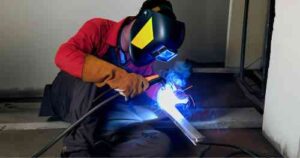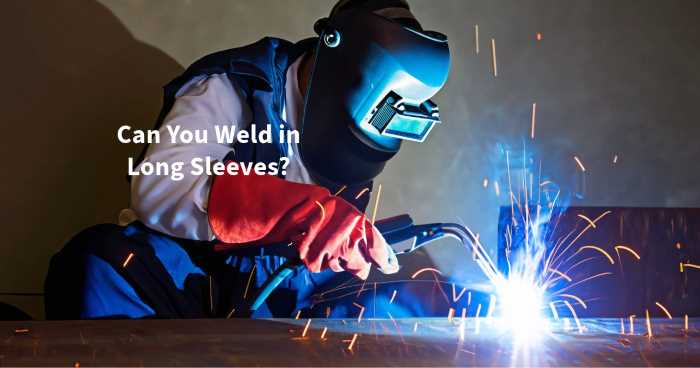Table of Contents
Welding is a skilled trade that demands precision and safety. One common question that arises among welders, especially those new to the craft, is whether it’s acceptable to weld while wearing long sleeves. In this article, we’ll dive deep into this topic and explore the nuances of welding attire, safety precautions, and the importance of the right clothing. Let’s get started.
Can You Weld in Long Sleeves?
While it’s generally not advisable to weld in long sleeves due to the risks mentioned earlier, there are exceptions. If you have flame-resistant long-sleeved welding jackets or shirts designed explicitly for welding, they can provide adequate protection. These specialized garments are made to withstand the harsh conditions of welding while keeping you safe.
However, it’s essential to inspect your welding attire regularly for any signs of wear and tear. Even flame-resistant clothing can lose its effectiveness over time, so be vigilant about replacing it when necessary.
Understanding the Basics of Welding
Before we talk about long sleeves, it’s important to understand the basics of welding. Welding is the process of joining two or more materials, typically metals, by melting their edges and fusing them together. This process generates intense heat, sparks, and potentially harmful UV radiation, making safety a top priority for welders.
The Importance of Proper Welding Attire
Welding is not your typical nine-to-five job. It involves risks and hazards that necessitate specialized clothing. Here’s why proper welding attire is essential:
1. Protection from Heat and Sparks
Welding generates extreme heat, and molten metal sparks can fly in unpredictable directions. Wearing appropriate attire, including long sleeves, helps shield the welder’s skin from burns and injuries.
2. UV Radiation
The intense UV radiation produced during welding can cause skin damage and increase the risk of skin cancer. Long sleeves provide an extra layer of protection against UV rays.
3. Metal Splatter
Molten metal can splatter during welding, and if it lands on your skin, it can cause severe burns. Long sleeves act as a barrier to prevent direct contact with splatter.
The Debate: Long Sleeves or Short Sleeves?
Now that we understand the importance of proper attire let’s address the burning question: Can you weld in long sleeves? The answer can be both yes and no, depending on the situation.
1. Welding Process Matters
The choice between long sleeves and short sleeves depends on the welding process. For processes like TIG (Tungsten Inert Gas) welding, which requires precise control and minimal spatter, welding in long sleeves is acceptable. In contrast, for processes like MIG (Metal Inert Gas) welding, which can produce more spatter, shorter sleeves or proper welding jackets are recommended.
2. Material and Environment
The type of material you’re welding and the environment also plays a role in your clothing choice. When working with materials that produce more sparks or splatter, such as stainless steel, wearing short sleeves with a welding jacket or apron might be the safest option.
3. Personal Comfort
Comfort matters too. Some welders prefer the added protection and insulation that long sleeves provide, even in less hazardous situations. However, it’s essential to ensure that the sleeves don’t impede your dexterity and control.

Safety Precautions for Welding in Long Sleeves
If you choose to weld in long sleeves, here are some safety precautions to follow:
1. Inspect Your Clothing
Before you start welding, inspect your long sleeves for any tears or holes that could expose your skin to heat or sparks. Make sure your clothes are in good shape.
2. Use Flame-Resistant Fabric
Opt for flame-resistant fabrics like cotton or treated cotton. These materials are less likely to catch fire if exposed to sparks or heat.
3. Button Cuffs
Choose long sleeves with button cuffs. This allows you to secure your sleeves and prevent them from accidentally sliding down while welding.
4. Proper Gloves and Helmet
Pair your long sleeves with welding gloves and a welding helmet with a suitable shade to protect your hands and face.
Materials Matter
Types of Long Sleeve Materials
When choosing long sleeves for welding, consider the following materials:
- Cotton: Lightweight and breathable, cotton is suitable for mild welding tasks.
- Leather: Leather provides excellent protection against sparks and heat but can be heavier.
- FR Cotton: Flame-resistant cotton is comfortable and safe for most welding applications.
- FR Wool: Wool is naturally flame-resistant and offers good protection.
Tips for Safe Welding
Best Practices
To ensure safe welding while wearing long sleeves:
- Maintain Distance: Keep a safe distance from the welding arc to reduce heat exposure.
- Secure Cuffs: Ensure that your sleeves are secure and won’t slide down during welding.
- Stay Informed: Stay updated on the latest safety guidelines and techniques in welding.
Conclusion
In conclusion, the question of whether you can weld in long sleeves depends on various factors, including the welding process, materials, and personal comfort. Always make safety your number one priority when welding. Ensure you’re adequately protected, whether you choose long sleeves or opt for shorter sleeves with additional safety gear.
FAQs
1. Is it safe to weld in short sleeves?
Yes, it can be safe to weld in short sleeves if you use additional safety gear like a welding jacket or apron, especially when working with processes that produce more sparks or splatter.
2. Can I wear a regular cotton shirt for welding?
While regular cotton shirts are better than synthetic materials, it’s recommended to wear flame-resistant cotton or treated cotton when welding for added protection.
3. Do I need to wear a welding jacket if I weld in long sleeves?
Wearing a welding jacket is advisable, especially when working with processes that produce more spatter. It provides an extra layer of protection.
4. What’s the best way to protect against UV radiation while welding?
In addition to wearing long sleeves, a welding helmet with a suitable shade and a welding curtain or shield can help protect against UV radiation.
5. Can welding in long sleeves affect my mobility and precision?
It can slightly affect your mobility, so it’s essential to choose comfortable clothing that allows for proper movement and control while welding.

